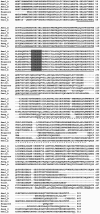Honey bee PTEN--description, developmental knockdown, and tissue-specific expression of splice-variants correlated with alternative social phenotypes
- PMID: 21779392
- PMCID: PMC3136494
- DOI: 10.1371/journal.pone.0022195
Honey bee PTEN--description, developmental knockdown, and tissue-specific expression of splice-variants correlated with alternative social phenotypes
Abstract
Background: Phosphatase and TENsin (PTEN) homolog is a negative regulator that takes part in IIS (insulin/insulin-like signaling) and Egfr (epidermal growth factor receptor) activation in Drosophila melanogaster. IIS and Egfr signaling events are also involved in the developmental process of queen and worker differentiation in honey bees (Apis mellifera). Here, we characterized the bee PTEN gene homologue for the first time and begin to explore its potential function during bee development and adult life.
Results: Honey bee PTEN is alternatively spliced, resulting in three splice variants. Next, we show that the expression of PTEN can be down-regulated by RNA interference (RNAi) in the larval stage, when female caste fate is determined. Relative to controls, we observed that RNAi efficacy is dependent on the amount of PTEN dsRNA that is delivered to larvae. For larvae fed queen or worker diets containing a high amount of PTEN dsRNA, PTEN knockdown was significant at a whole-body level but lethal. A lower dosage did not result in a significant gene down-regulation. Finally, we compared same-aged adult workers with different behavior: nursing vs. foraging. We show that between nurses and foragers, PTEN isoforms were differentially expressed within brain, ovary and fat body tissues. All isoforms were expressed at higher levels in the brain and ovaries of the foragers. In fat body, isoform B was expressed at higher level in the nurse bees.
Conclusion: Our results suggest that PTEN plays a central role during growth and development in queen- and worker-destined honey bees. In adult workers, moreover, tissue-specific patterns of PTEN isoform expression are correlated with differences in complex division of labor between same-aged individuals. Therefore, we propose that knowledge on the roles of IIS and Egfr activity in developmental and behavioral control may increase through studies of how PTEN functions can impact bee social phenotypes.
Conflict of interest statement
Figures






References
-
- Barbieri M, Bonafe M, Franceschi C, Paolisso G. Insulin/IGF-I-signaling pathway: an evolutionarily conserved mechanism of longevity from yeast to humans. Am J Physiol Endocrinol Metab. 2003;285:E1064–1071. - PubMed
-
- Oldham S, Hafen E. Insulin/IGF and target of rapamycin signaling: a TOR de force in growth control. Trends Cell Biol. 2003;13:79–85. - PubMed
-
- Normanno N, De Luca A, Bianco C, Strizzi L, Mancino M, et al. Epidermal growth factor receptor (EGFR) signaling in cancer. Gene. 2006;366:2–16. - PubMed
Publication types
MeSH terms
Substances
Grants and funding
LinkOut - more resources
Full Text Sources
Research Materials
Miscellaneous

